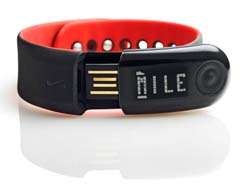Pedometers used to be mechanical devices paired with rudimentary counters that aren’t very accurate. If you shake it, you can hear the sound of the ball bearing slamming into the switches, bringing back memories of your poor schoolmates in the Trim And Fit club who were forced to purchase one of these cheap devices.
Nike changed the image and accuracy of pedometers when they first introduced Nike + iPod Sport Kit in 2006. Combining an iPod and an accelerometer, Nike allowed runners to listen to music, receive audio feedback and measure their runs. Runners can select a Power Song for their final leg in their run. But what if you don’t possess an iPod or simply hate music?
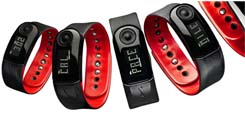
Nike’s answer to that is to release the Nike+ SportBand. Instead of recording your runs in an iPod, the pedometer in your shoes now communicates with a device that you wear on the underside of your wrist.
Comfort and Aesthetics
Inspired by Lance Armstrong’s Live Strong band, the Nike SportBand is made with hope that people will wear it as often – as a fashion statement and with symbolism of running as how the yellow band is to the support of cancer patients and research. Physically, the Nike SportBand is made out of a similar material.
Worn like a wristwatch, except with the display screen on the underside of the wrist, the design of the bracelet is simple. There is a solitary round button beside the screen and another smaller button concealed at the side of the detachable link. The band itself is black in colour, with the inner side dyed a stark contrasting red.
The soft flexible material held the device firmly, but comfortably, in place. This is despite having worn it for more than an hour. Unfortunately, silicon is as permeable as it is comfortable, resulting in sweat trapped between the wrist and the band. Removing it after a long run was a slightly disconcerting affair, with sweat droplets splashing around unglamorously.
Bearing this in mind, it’s unrealistic to expect wearers to emulate the Live Strong experience and to constantly wear it; Nike might have forgotten that while the Live Strong band is also made of silicone, it dangles loosely on a person’s wrist, contrasting to the tight grasp of the SportBand.
The flat pedometer sensor is placed under the sockliner in a Nike+ shoe and is not felt by the runner.
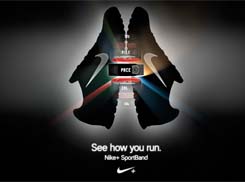
The Nike+ SportBand Experience
You reach home, tearing open the Nike+ package excitedly. You read the instructions. Unlike its predecessor, you have to first download a utility from nikeplus.com, since you can no longer sync your runs with iTunes.
Annoyed, you search frantically for the download section, but got lost instead. You read the instructions again. Then you go to nike.com/downloads and download the Nike+ utility. It takes up 5.1 MB in your MacBook Pro. That’s not a lot of space, you think, but it’s still quite troublesome. When Nike collaborated with Apple for Nike + iPod, the former certainly didn’t inherit Apple’s intuitive user-friendliness.
You then insert the SportBand link into the USB port of your laptop computer. It takes about 2 hours to fully charge it and lasts for 8 hours. The device can hold up to 16 hours of data.
What excites you is the fact that you can trace your runs in the website and locate other routes that had been traced before by other runners. You trace a 3.5km warm-up route around your neighbourhood.
There’s also a cool function called Nike+ Coach that has training programmes, ranging from “Walk to Run” for beginners and a full marathon for the more gung-ho ones. For added pressure/encouragement, you can also set goals online. You contemplate stoking the competitive beast in you by issuing a challenge to other runners. You decide against it, for now.
After wrestling the insole out of the shoe, you remove a foam insert and place the sensor in the specially created compartment. You feel slightly uncomfortable, as you are accustomed to your regular running shoes. Regrettably, this product is best used with Nike+ shoes, which is characterised by the swoosh logo with a + sign, as accuracy is compromised when the pedometer is not firmly in place.
Weighing 6.5 grams, the piezoelectric sensor has an in-built non-rechargeable and non-replaceable battery that lasts for approximately 1,000 hours or 3 years of usage, according to Nike. The sensor will only be activated when it detects motion that exceeds 4km/hr. This means that, you thought with a grimace, you have to stick your hands into your smelly shoes after a run to remove the device, and would need to purchase another sensor after 1,000 hours of running and/or walking.
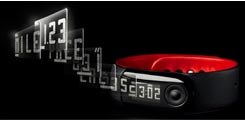 Your first trial of Nike SportBand was sheer disappointment. Other than the fact that you had to squint at the screen at dusk because the SportBand has no backlight, the running experience was pretty uneventful – press and hold the button beside the display screen for 3 seconds to connect your SportBand to the sensor, press once to start recording, press once again to pause recording, and hold it for 3 seconds to end the run. During the run, you press the toggle button at the side to view the time, pace, distance and calories burnt. Nothing has gone terribly wrong yet.
Your first trial of Nike SportBand was sheer disappointment. Other than the fact that you had to squint at the screen at dusk because the SportBand has no backlight, the running experience was pretty uneventful – press and hold the button beside the display screen for 3 seconds to connect your SportBand to the sensor, press once to start recording, press once again to pause recording, and hold it for 3 seconds to end the run. During the run, you press the toggle button at the side to view the time, pace, distance and calories burnt. Nothing has gone terribly wrong yet.
The moment you reached home (and after taking a quick shower), you insert the SportBand link into your laptop’s USB port. The Nike+ Utility automatically downloads the run’s measurements and storing it in your account Nike+ account. So far so good, you thought.
However, after viewing the graph on the website, you realised with an unpleasant jolt that, even though you ran 3.5 km, your measured statistics are as follows.
Recorded run: 1.24 km
Duration: 14 minutes 09 seconds
Speed: 11mins/km
Calories burnt: 74 calories
According to Nike, the median average accuracy of Nike+ is placed at 92%, without calibration, 97%, with calibration. Judging from the results above, the SportBand far exceeds the error margin.
You decide to calibrate the device. This time, it’s definitely much better.
+ or –
The Nike+ SportBand is comfortable to wear and relatively easy to use. It’s also very helpful for runners who dislike listening to music while running or who don’t have an iPod.
Andrew Lee, 24, teacher, said, “I didn’t like the iPod because the rhythm of the music screws up my breathing momentum and my oxygen intakes, resulting in stitches and an irregular running pace.”
“Also, I’ll constantly try to estimate the time I took to run using the number of songs. So if two songs have finished, I’ll guess and screw myself in the head with statements like ‘What?! It’s 8 minutes already and I’m still here?’” The regular marathon runner added.
The pedometer also motivates people to start running, and encourages them to continue running by tracking their progress. Student Elsa Tan, 18, said, “Even though I’m in my school’s track team, I don’t see myself as a very good runner. I am really too lazy to train regularly, but with this, I am actually motivated because I can see my progress over the weeks.”
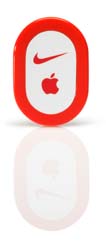
Can be improved
However, much can be improved. The non-replaceable and non-rechargeable battery in the pedometer lasts approximately 3 years. No one likes making an investment that can only promise returns for such a short period of time.
By using a accelerometer, instead of the more sophisticated Global Positioning Satellite (GPS) system, customers, who might be more comfortable with their regular running shoes, are forced to wear Nike shoes that are custom-made for the device. In terms of non-replaceable battery and custom-made shoes, customer cost-efficiency is extremely low.
In addition, as advanced as mechanical technology might have improved over the years, one cannot help but to question the accuracy of a pedometer that attempts, in a rather primitive fashion, to measure distance by the movement of one’s leg.
While the Nike+ Utility makes downloading run statistics and saving it in the online account an absolute breeze, it’s also unnecessary work for a person who is only interested in running. It would be an added-value if there is a more seamless integration of the devices. An automatic download of the programme the moment the SportBand link is inserted into the computer is very much preferred over constant reminders to download the utility, from some website where the user might get lost in, before actually inserting the device into the computer.
There’s also a minor complaint that some might deem frivolous, yet it’s definitely one, UrbanWire can assure you, which will doubtlessly get on your nerves with sufficient time. The link is designed curved downwards. This means that it is impossible to insert it in a laptop computer without first propping the computer at an angle.
The lack of a backlight will also be a source of irritation for runners who run in the early morning or at night.
In short, the Nike+ SportBand has no 1 major flaw. Instead, it’s the coalescence of several small imperfections that might prove discouraging to a runner who is not particularly interested in Nike or gadgets in general; it is quite clear that it is an unwise decision to purchase this product out of its sheer novelty.
“Join the world’s largest running club,” Nike proclaims on its website, referring to owners of Nike+. On 31st August 2008, Nike+ has organised a mind-blowing wonder, especially for the members of this club, that you certainly don’t want to miss out on.
More details about the event will be released at a later date. For now, UrbanWire thinks that, novelty notwithstanding, it’s a splendid idea to purchase this product if you have the luxury of excess spending power and if you think that this is a perfect excuse to get you off your bum and onto the roads running.
After all, Lance Armstrong, whose yellow Live Strong bands had inspired the design of the Nike+ SportBand, once said, “Pain is temporary. It may last a minute, or an hour, or a day, or a year, but eventually it will subside and something else will take its place. If I quit, however, it lasts forever.”

